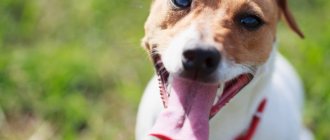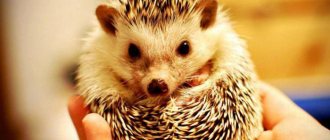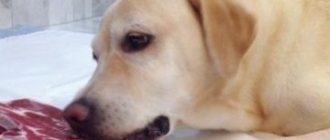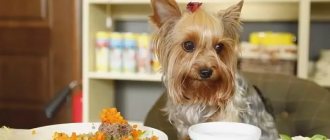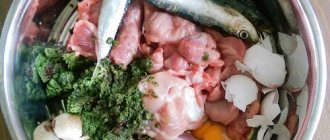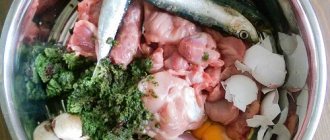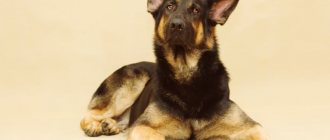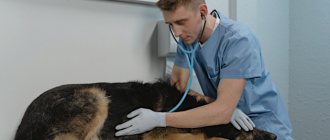The birth of puppies is an event for which you need to carefully prepare. One of the important factors in the growth process of an animal is nutrition. Owners should familiarize themselves with the feeding habits of newborn puppies in order to minimize the development of gastrointestinal diseases. You can find out what to feed one-week-old and one-month-old puppies from the article.
Feeding small puppies
Basic feeding rules
How to feed a puppy from birth without a mother is a common question for dog lovers who are faced with their offspring refusing mother’s milk. When choosing a diet for dogs, it is necessary to take into account some important conditions that veterinarians note:
- babies need to be fed at the same time every day;
- food for animals should be warm, but not hot;
- after eating food, it is worth postponing active games so that the food is absorbed in the body;
- Puppies need clean, plain water. Therefore, they must have access to it constantly.
- It is not recommended to mix dry food with natural food. If initially the offspring ate natural food, and now the owner wants to introduce purchased food into their diet, then it is worth discussing this issue with a veterinarian. A sudden transition to a new food can trigger the development of stomach diseases;
- the use of salt should be kept to a minimum;
- Artificial feeding of puppies takes place using special baby food enriched with vitamins, minerals, and microelements.
Important! The main rule of feeding puppies of any breed (Yorkie, Bulldog, German Shepherd, French Spitz, Husky, Chihuahua, Terrier) is to fill the diet with vitamins and amino acids for full development.
Nutrition for babies from 2 months
Additional baby care
To track the well-being of newborns, it is better to keep a special journal. It is convenient to monitor the frequency of meals, weight gain, stool consistency and alarming symptoms.
In addition to artificial feeding, caring for orphan puppies includes the following actions:
- Maintaining temperature in the “nest”. In the first 7 days it should be 30°C, in the second – 27°C, and in the third – 21-23°C. A heating pad or a special lamp for the incubator is suitable for heating. In both cases, the animals should be able to crawl to an unheated area when they feel hot. Otherwise they may overheat.
- Regular diaper changes and body cleanliness control. The immature urinary system of newborns does not allow urinary control. Because of this, kids constantly walk under themselves and can catch a cold from the dampness. In the absence of a lactating bitch, their dryness should be controlled by the owner.
- Using ointments for diaper rash. A humid environment is nutritious for bacteria and other pathogenic microorganisms, so along with hypothermia, small four-legged animals can develop skin inflammation. To prevent this form of dermatitis, the affected areas must be lubricated with any soothing baby cream.
- Taking your temperature before every meal. When the value is below 35.5°C, problems with digestion occur, leading to intestinal obstruction. If the thermometer shows too few degrees, warm your pet with your body heat by placing it under a sweater or other clothing.
- Accounting for weight changes. Newborns are weighed for the first time on the 2nd day of life. After this, changes are recorded daily. On average, the increase is up to 5% of the weight for the previous day. Stunted growth and even slight weight loss are acceptable only in the first 7 days. If on the 8th day the situation remains the same, contact your veterinarian.
- Massage before and after meals. It is necessary to stimulate the gastrointestinal tract. Massage is done with a damp cloth or cotton pad soaked in warm water, in the direction from the navel to the anus. Urine and feces appear quite quickly, within 1-2 minutes. They are carefully removed, avoiding drying out on their own.
After massaging the tummy, babies immediately fall asleep. This behavior in the first 7 days of life is absolutely normal and does not require help from a veterinarian.
Independent artificial feeding of a newborn puppy
How to feed a newborn puppy without a mother at home is one of the main questions for many dog breeders. If children refuse breast milk, they can be fed artificially, that is, food that is rich in macroelements, fiber, and vegetable protein. What to feed newborn puppies without a mother will be discussed below.
Features of feeding a dog with baby food
Despite the fact that baby food contains virtually no harmful additives, it should not be the main food for puppies. With frequent use of these products, animals may develop gastrointestinal pathologies. For newly born babies, 1-2 spoons of natural mixture per day is enough. When choosing food, you must carefully study the composition of the products. Food should not contain preservatives, large amounts of dyes, or aromatic additives. Puppies need to be fed fresh food.
Preparing a mixture for feeding puppies
What to feed puppies if the dog does not have milk is one of the popular questions on pet forums. If the mother does not have milk or she refuses to feed the newborn puppies, then you can prepare the milk formula yourself. To prepare it, use boiled water and glucose or boiled milk and 1 raw chicken yolk. All ingredients are thoroughly mixed until a homogeneous mass is formed, filtered through cheesecloth, boiled for 5 minutes, cooled to room temperature. Be sure to give your pets the mixture on the day it was prepared. Babies should not be fed food that is not fresh. This can negatively affect their stomach function.
Important! Dog breeders should take into account that all utensils in which dog food will be prepared must be sterilized and disinfected. Before feeding, you need to check the temperature of the mixture so that it is not too hot.
Puppy feeding position
The most optimal position for feeding small dogs is lying on their stomach with their head slightly raised. In this position, babies digest food better and cannot choke. To prevent puppies from choking, dog owners must monitor their breathing and behavior. If the animal's heartbeat accelerates, you need to pull out the pacifier so that the pet can fully swallow the food.
Feeding a newborn baby
Step-by-step description of the procedure
Most often, dogs are bottle-fed with a nipple, but for small breeds a syringe and dropper are also suitable. The feeding procedure consists of the following steps:
- Disinfection. To avoid infecting babies, the owner must thoroughly wash their hands with soap and boil the milk container.
- Warming up. Powdered milk is diluted with water before each feeding and brought to a temperature of 38-40°C. If in the end there is something left in the bottle, then it is poured out.
- Correctly picking up a puppy. The small pet is placed on the lap with its tummy down and its head is gently lifted, imitating the natural position when suckling the breast.
- Putting down the bottle. It is held at an angle of 45°, avoiding too much pressure. Otherwise, the baby may choke. If the puppy himself tries to drink everything in one gulp, then take several forced breaks.
- Helps remove excess air. Once fed, the four-legged animal immediately turns away from the nipple. At this point, its position is changed to vertical and held for about 2 minutes until regurgitation.
A well-fed baby is placed in the opposite direction from his hungry brothers. This way you won’t confuse those who ate and those who didn’t – this especially helps if there are a lot of “babies” in the litter.
ADVICE!
If your pet pushes the pacifier away with its paws, swaddle it, limiting its mobility.
A hole in the nipple is punched with a hot needle. It shouldn't be too big or too small. Puppies should suckle easily without exerting too much force. If the liquid flows freely in a stream, make the hole smaller.
First feeding of puppies
Complementary feeding begins on the 20th day of life of the offspring. During this period, they are teething, so it becomes painful for the mother to feed them. The type of complementary feeding depends on the nutrition of the parents. If the mother eats dry food, it is recommended to give it to the children as well. If the dog is kept on natural food, it should also be prepared for the offspring. The transition should be gradual. At first, complementary feeding is carried out once a day, the rest of the time the puppies eat their mother's milk. Then - 2-3 times a day. When the offspring completely refuses mother's milk, they need to be fed 5-6 times a day with the selected type of food.
Protection from diseases
With mother's milk, puppies not only receive the opportunity to grow and develop, but also protection from many diseases, thanks to the immunoglobulins contained in bitch's milk. Artificial feeding deprives babies of such protection.
vaccination by the age of 4 weeks to protect him from diseases such as parvovirus enteritis and canine distemper. To resolve this issue, you definitely need to seek the help of a veterinarian.
When the puppies are 1 month old, they need to be wormed . Anthelmintics are given 2 times with a break of 10 days. It is important that the baby receives exactly the dose that corresponds to his weight and age. To do this, read the instructions, which usually describe everything in detail.
When should you start feeding the first food and how long will you need to act as a dog mom? Typically, by 3 weeks, puppies become active: but they still need to be fed! But at 4 weeks (21-25 days), the puppies’ fangs begin to erupt, so you can slowly begin to feed the puppy.
Feeding the puppy natural food
If a decision has been made to switch babies to natural food, then dog owners should not add dry food to the menu at the same time. This leads to stomach diseases. Natural food should not be too fatty or salty. It is also worth excluding smoked meats. The menu may include the following products:
- meat (beef, chicken);
- vegetables;
- milk;
- porridge;
- bran;
- cottage cheese;
- kefir.
Important! The pet's diet should be balanced. That is, with the presence of the required ratio of BJU, minerals, and vitamins. I’m writing it’s better to steam it.
Creating the required temperature regime
Puppies, unfortunately left without their mother, are immediately exposed to various dangers. One of these dangers is their overheating or, conversely, hypothermia.
The baby's body is not yet fully formed and cannot regulate its body temperature. Usually this function is performed by the female. If the puppy is cold, he moves closer to his mother and warms himself against her; if he feels that he has warmed up, he moves away.
Therefore, an important point is to artificially create the thermal regime necessary for the puppy. It is important to remember that a drop in a puppy’s temperature to 34 0C leads to irreversible consequences, and sometimes even to their death.
If the search for another lactating female is successful, then there will be no problems with the temperature regime. If not, then you will have to make something like an incubator for the puppy. You need to find an ordinary box and place a lamp above it, the flow of light of which must be directed into the box.
It is necessary to organize everything so that the puppy can leave the box if he gets hot, since overheating is also dangerous for his health.
In addition to this method, you can also warm the puppies with your warmth by placing them on your stomach. However, this takes too much time.
Another option is to use special electric heating pads that are placed under the box. They need to be placed so that there is room in the box for the puppy to climb into if it gets too hot.
Feeding volumes and schedule
How much food to make per day by volume is a common question among dog breeders. The dosage of daily servings depends on the weight of the dogs. In about a day, the puppy should eat about 8% of its current weight. That is, if a small pet weighs 2 kg, then he needs to consume no more than 160 g of food per day.
From two to four months
At 2 months of age, dog owners can introduce more solid foods every 3-5 days to get the puppies accustomed. This includes lamb, fish products, carrots, and zucchini. What is the menu for the day:
- morning - cottage cheese with milk;
- second breakfast - boiled meat, rice, vegetables;
- lunch - cottage cheese and raw egg;
- afternoon snack - turkey, stewed vegetables;
- dinner - boiled cabbage, raw meat.
You can add fish oil to your diet to strengthen your body.
Feeding puppies from 4 months of age
From four to six months
How to feed pets, menu for 1 day:
- breakfast - cottage cheese with milk, fruit;
- lunch - liver (kidneys), boiled rice, vegetables;
- afternoon snack - kefir, cottage cheese;
- dinner - boiled meat, fish with vegetables.
At this stage, you can reduce the number of meals to 4 per day. Is it possible to feed a puppy with cow's milk? Breeders often ask. It is not advisable to feed babies full-fat cow's milk alone. It can harm the functioning of the stomach.
From ten to twelve months
Sample daily menu for puppies:
- morning - alternate meat and dairy foods every other day;
- evening - boiled meat/fish with rice and vegetables.
From 10 to 12 months of age, animals are fed 2 times a day.
Important! To strengthen the body, you can also introduce fish oil and natural mineral supplements into your diet.
Finding another lactating female
The first option to solve this problem is to find another lactating bitch and place the puppies with her. In such a situation, you need to know some tricks, because the dog may refuse to feed puppies that are not its own.
- In the absence of the wet nurse, it is necessary to mix her puppies with step ones. This is done by placing the puppies one at a time - one of your own, one of someone else's, and so on. This is necessary so that other people's puppies acquire the same smell as her own puppies.
- Afterwards, you need to start the nursing female and place all the puppies under her as quickly as possible. There are cases that bitches are very aggressive towards other people's puppies, so it is better to put a muzzle on her before the first procedure. In it, she will not be able to harm the puppies, as well as the person who started all this.
- After attaching the puppies, you need to remove the muzzle from the dog and, holding it by the collar just in case, watch it. If she begins to lick all the puppies, then the procedure was successful and you don’t have to worry anymore, she mistook strangers for her own. If a dog, after removing the muzzle, tries to harm other people's puppies, you need to take it away for 10-20 minutes, and then repeat it all over again.
IMPORTANT! Until the dog has licked all the puppies, do not leave them alone under any circumstances. Otherwise, she may bite them to death.
When can you switch to dry food?
They switch to dry food when the puppies' teeth are formed and strengthened. It is better to introduce dry food into the diet at the age of 6-8 months. Depending on the breed, the period may vary less or more. When switching to dry food, it is necessary to minimize the amount of natural food in the diet. Combining feeds can negatively affect the functioning of the gastrointestinal tract.
Nutrition of newborn puppies is an important moment in their development. The diet should be filled with vitamins and minerals, fiber, and amino acids. If the dog refuses to feed the puppies, then milk formula and baby food are added to the menu. After 2-3 weeks, the first complementary foods begin. At the age of 2-3 months, the dog can already be accustomed to nutritious food, gradually adding new products to the menu.
Special blends
It is extremely important to choose an adequate substitute for breast milk, because it is not just food, but the only source of nutrients, microorganisms necessary for the development of the body and the creation of primary immunity in the baby. Under no circumstances should regular milk be used for these purposes.
There are two ways to replace breastfeeding for a real mother:
- Making homemade formula from cow's milk that needs added nutritional value. To do this, add 1 egg yolk, 2 drops of vitamins A, D and 2-3 ml of vitamin C (ascorbic acid) to 100 ml of liquid. The entire composition is stored for no more than a day and is heated to a warm state if necessary.
- Special milk substitutes produced industrially. This is the most suitable option, since the mixture already includes all the nutrients in the required proportions. The owner can only dilute the powder to the required consistency, following the instructions. Many manufacturers around the world produce special nutrition for breastfeeding, so you can easily find the right one.
General recommendations
Veterinarians usually emphasize how harmful overeating is for a dog. But lack of food can also cause her health problems. To avoid this, be sure to follow a few simple tips:
- The puppy should always have access to clean water at room temperature. The drinking bowl should be washed regularly.
- It is necessary to create a feeding schedule and not violate it.
- Portions should be calculated based on weight parameters.
- If your pet has eaten much less than usual, there is no need to increase the amount of food at the next feeding.
- There is no strict schedule for the diet, but you cannot replace one product with another that is unequal in composition and nutritional value - for example, put more cereals in a dish rather than meat.
- If you refuse a certain product, you should not worry or force your pet to eat - it is better to give him what he likes.
- Each meal should last no more than 15 minutes. If during this time the puppy has not eaten everything, the owner needs to put the remaining food in the refrigerator.
- Plates with food are placed so that the dog does not have to bend over to them. Otherwise, this will lead to improper formation and development of skeletal bones. An adjustable stand with a tripod will help avoid this.
- You can’t have an active pastime immediately after eating - you should wait 1-2 hours and then start walking, playing and training with your four-legged friend.
Providing proper and balanced nutrition for a growing pet is not difficult. You just need to remember which foods are recommended for the puppy and which are strictly prohibited, and also strictly follow the feeding schedule. If your four-legged friend is cheerful and cheerful, his coat is smooth, shiny, and his teeth are healthy, then all this indicates the right choice of food for his pet and the owner’s care for him.
Reviews
Alisa, Kazan
“I feed my Yorkie Pronature. I believed the positive reviews on the Internet - and did not regret it. It contains only natural meat, flax seed, vitamin-rich apples, carrots, and cranberries. I like that vitamin E is used instead of preservatives. After switching to this food, the dog’s digestion returned to normal. It can be seen that the granules are well absorbed. The Yorkie has a lot of energy, and all the tartar on his teeth has been cleared.”
Mikhail, St. Petersburg
“We bought a Spitz for the child. The breeders fed him Acana, but we decided not to change the diet. We feed dry granules for miniature breed puppies, everyone is happy. The Spitz has a good appetite and plenty of energy. No eating disorders or allergies were noted. And, most importantly, the fur has become very beautiful and fluffy.”
Appropriate place
The puppy (or puppies) need to be provided with a comfortable and warm place in a draft-free room where he will stay for the first weeks of his life. For a bed, for example, you can use a box or a wicker basket. Diapers are placed there, which must be changed regularly, since usually the mother maintains cleanliness by licking her offspring, and without her the baby will dirty the bedding. You should put a heating pad or a bottle of hot water in the bed, wrapped in a towel so that the puppy does not get burned. And change the water as soon as it cools down. This way you can imitate the warmth of your mother.

